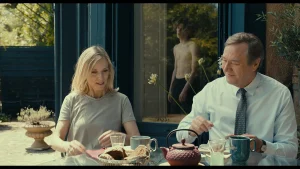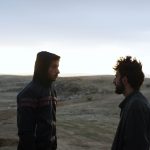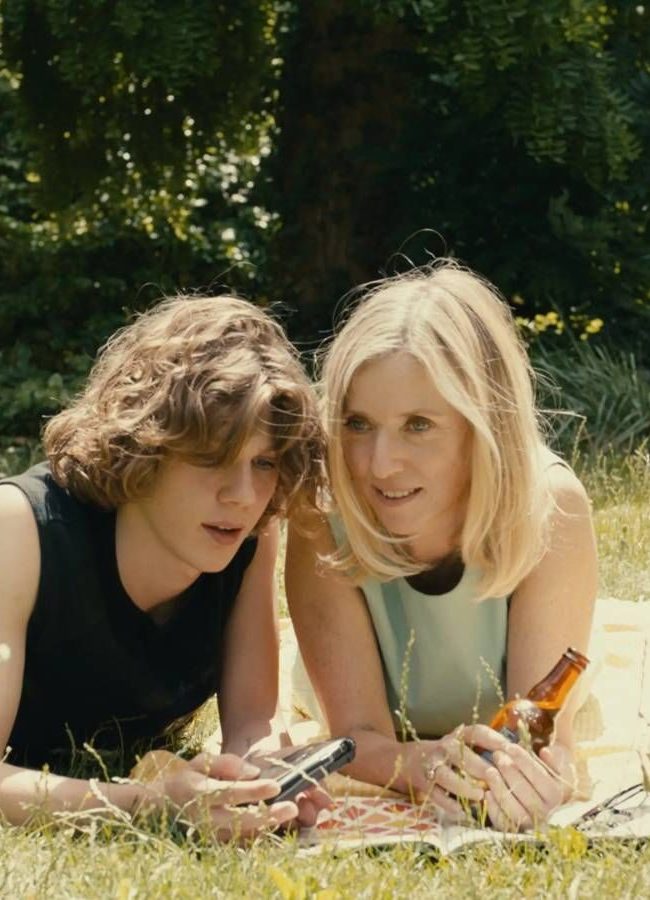A Conversation with Catherine Breillat (LAST SUMMER)

Last Summer was written and directed by Catherine Breillat. The film premiered in the main competition of Cannes in 2023. Breillat is a legendary French filmmaker who is responsible for masterpieces such as Fat Girl, Romance and, The Last Mistress. Her films became known for their distinctive look and depictions of sexuality. With Last Summer it is not only a return to her usual thematic playground, it is a major return to form. A decade removed from her last feature and she creates one of the best films of her career. It is an astonishing feat and should be seen in theaters this summer. It was amazing to speak with her in the following conversation edited for length and clarity.
Hammer To Nail: With Last Summer you are returning to the directing chair for the first time since 2013s excellent Abuse of Weakness. What brought you back to filmmaking for this story!
Catherine Breillat: I was approached by my producer, Saïd Ben Saïd and he told me that he had acquired the rights to a Danish film called Queen of Hearts. He thought I could make it better! At this point I had decided I would not make any more films because the press in France was so harsh on me. It completely killed my ability to work. I had written a few scripts, some of which were not so bad, but I could not find financing. I had no future in this work and I really thought I would not be able to make another film until Saïd Ben Saïd approached me! In the original film I loved the device of the lie. That was something I knew I would keep as is. The things I changed was the crudity of the sex scenes and how visually overt it was. I thought the teenager looked too old in the Danish film. I needed him to be younger and embody that more magical state. He would be the one to seduce her, not the other way around. I felt incapable of portraying a woman as a predator. A film is not what it is on the page. It is what happens between the flesh of the actors. The film really became my own. It was my fantasy.
HTN: The castings of Anne (Léa Drucker), Théo (Samuel Kircher) and Pierre (Olivier Rabourdin) were key to the film’s success. Each actor embodied the role so well. Can you talk about the casting process for this one?
CB: It all happened very fast. It was 4 weeks altogether. The character of Anne was actually written for a different actress. She pulled out because of some anxiety surrounding the sex scenes. Leanne read the script and loved it even though she had never done anything like that before. She had never done any intimate scenes in her career. She trusted me entirely.
HTN: The summer film is a genre itself. I love summer films like Tale of Summer or more recently Afire. This one is different because it deals in the consequences of a summer fling. Was the idea of subverting the summer genre something on your mind and if not, did you watch any films in prep for this shoot?
CB: I am very artisanal in my way of making films. I definitely used the summer to my advantage with the aesthetics. For example the lighting is perfect in that sequence in the grass. At other times the heat was getting in the way of things and I had to find a way to breathe a sense of cool into the film. That is always part of the illusion with cinema. Fat Girl was shot in April but made to seem much colder than it actually is.
HTN: The aesthetic of this movie can be very hazy, breezy and light like a summer itself, It can also feel tight and cloaked in dread. What were you Jeanne Lapoire going for with the look of this film? What were you and Damian Luquet going for with the sound?

A still from LAST SUMMER
CB: I do not go for anything I find it. I find by doing. There were scenes with Jeanne Lapoire where we had been filming for a while and I would stop her and give her new instructions. I said once, “get Lea to stop moving, I need her imobile. We also need to change the light because her skin needs to be completely white and her eyes blue like a Hitchcock movie.” This is particularly true for the trial scene. Samuel came down the stairs, the light source was coming from behind Lea. We were about to shoot and I stopped it and started screaming at Jeanne, “I told you I would not film her if eyes are not blue!” She said, “It is not possible, the light is coming from behind!” I said, “I don’t care! I am not here for realism! We have all the tools here. We have the lights. I am here for expressionism.” That is how the truth of the scene can be revealed. Sometimes the naturalism of the wind, of the sunlight can be really beautiful. The rest of the time we have the tools like a painter to decide how we want it to look. It is the beauty of the artifice which is true. The point of the scene is for her eyes to be as blue as her dress is. This glacial, icy mystery that she has, The reality beyond that I do not care about. The sound I was less involved in. The sound engineer was terrific. He was also standing in for Lea whenever we were rehearsing. Everything he did was great.
HTN: After making love with Pierre she tells him that she likes a “body that’s lived…that’s lost the firmness of youth, it touches [her] it moves [her].” What was your thinking behind this line which ultimately contradicts her actions?
CB: There is no contradiction, she does actually love her husband. She also loves Théo. It is a sequential thing. It was important for me to show that she is not frustrated in any way. She is part of a loving relationship. They still have a satisfactory sexual relationship. It may not be the throes of passion that come later in the film, but this love and tenderness between them not only exists but is very important. When you love someone, if they are thin, you love thinness. If they are ugly, you love their ugliness. If they have fat you love their fatness. It is about the love of the person, not the image of what they are. This is how I feel. I find a body like Pierre’s to be truly beautiful and very moving. That is something that I have focused on in my films before. Dirty Like An Angel for example. The bodies of men that are moving away from their firmness. I would always say ‘I did not love beauty’ even though all of the men I have been with have been incredibly beautiful. When I was a teenager my fantasy was Sherwood Anderson with those bags under his eyes. This was part of my imagination but in reality I would never sleep with a man like this.
HTN: The moment by the lake has a lot of interesting things going on. Théo eating the Big Mac and breaking his 2 year vegetarian streak, Anne not wanting to go in the water but being convinced. What about this moment subtly sparks attraction for the two of them and why was it essential to this story?
CB: That is what my son did. Everything in my movies comes from something real. Anne always says, “no,” and then does what she said she would not. That is the first time she contradicts herself. What matters in this scene is Anne’s violence. When they are playing in the water, Theo is involved in very boyish behavior. He is being slightly aggressive to the girl he likes. What changes the dynamic is her act when she rushes towards him and pushes his head under water. I wanted that moment to feel real. Like she could get rid of him if she needed to. That was difficult to get out of Lea. She was not drowning Théo with enough force. We needed him to come back to surface out of breath in a way that would make an impact on the film. Maybe we would think that everything would be a lot more simple for her if he just did not exist. I think in life, a lot of love stories begin with an act of aggression. This is a way people signal to others they are attracted to them. We express that we want them to disappear when it’s really the opposite.
HTN: At the 28 minute mark there’s an important moment. After their swim in the lake they are driving home. The kids are asleep in the back and as the sun sets and they ride with the top down, Dirty Boots by Sonic Youth plays. Why did you want to include this moment in the film?
CB: I like cliches. It is not the sun that is setting but the full moon is rising. At this moment you see the peace that they have together. This joyous moment. They have somehow in this moment become the parents with the kids sleeping in the back. The honeymoon of a young couple. The full moon was actually a happy accident. We did not have the money to plan for that kind of thing.
HTN: I feel like the idea/act of kissing is a key to this film. The first time we see Anne kiss is with Theo. The shot is extremely up close and personal. When she is having sex there is never any kissing. Was this something that was on your mind? And If you could generally talk about what you were going for with this first kiss sequence.

A still from LAST SUMMER
CB: You either kiss or you have sex. If you are having sex you are not kissing. I do not associate the two. The idea of that first scene would be that it would feel like an adolescent kiss. Something irresistible and surprising happens. You did not know it would happen and it was not possible that it would happen, that’s the shock value. Hopefully it feels as if two people in front of you at the movies started to kiss. This appetite to devour each other is interminable. What is interesting to me here as in all acts of love is this fact that the second before it happens it was impossible, they were just friends. Thanks to that I was able to do the ellipse and not show the stuff like who undresses who, things I don’t really care about. We put the camera on him to watch him make love so we can see the passion he has towards her. She is the object of his desire.
HTN: The moment of confrontation is truly amazing. That brief pause Anne takes where the audience is guessing whether she will fess up or dive head first into a lie denying the whole affair is perfect. Leas performance at this moment is incredible. Did you give her any specific directions here and what were you thinking watching this moment on set?
CB: I was thinking about Vertigo. I needed her to be absolutely impenetrable and frozen at that moment. Inside she is completely liquidated; on the outside she needed to be a block of ice. She also needed to be beautiful. I believe that beauty gives opacity in this way. The way I showed her how to go from sitting to standing was very specific. In the process of standing she finds how she will get out of this. She creates what she will say. When I was looking at the frame from behind the camera I knew that visually he was on top of her so it would have to be the power of her eyes that would allow her to rise above him.
With each take I would tell her to move her eyes slower and slower, because she is not eager to reach that top and eventually become what she is. She has to be a great defense lawyer at this moment. In France, being a defense lawyer, the whole art and craft stems from being able to tell a shameless lie. It is to deny what is evident. These moments are what I would call my expressionist shots. I tried to direct the scene against what an actor would instinctively do. I broke all her tools in this scene. She would normally give it her all and spill her guts out at this moment. I did the exact opposite because the words themselves are very violent. They will scream on their own. By staying as cold as she is by staying like marble she dominates him. He believes her or rather instigates doubt because she does not scream.
HTN: In the moment where Anne and Pierre reconcile after their potentially relationship ruining fight, the focus is on Pierre as he cries. Why did you only focus on his face at this moment? It’s quite a powerful one.
CB: I stayed with him because he was magical at that moment. If she was magical it would be her we would see. I always stay with who is magical. What he delivered in that moment I had never gotten from a male actor before. She had to slap him 14 times before we could get to the level of emotion we needed. It was difficult for him to cry at first. I resisted using fake tears because they do not move anyone. I told him, “it is about concentration, it is about the ability to go in the layers of one’s inner soil, to find the suffering and release it. Eventually he did and we stayed with him. There was originally going to be dialogue there but we cut it out because in a moment like this the silence is really enough. The way he holds her is very specific as if he is drowning. It’s a real testimony to how much he loves her at that moment. It is important to know when to end a scene. When you find that truth, when you get to the beautiful thing you stop.
– Jack Schenker (@YUNGOCUPOTIS)











